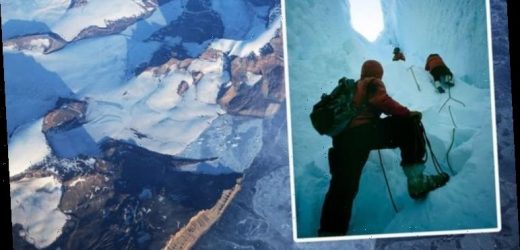Antarctica: ‘Ancient remains’ discovered in valley after ice melts
The southernmost continent is home to around 1,000 researchers every year, who monitor climate change and study Earth’s history. After World War 2 this barren landscape risked becoming another battleground as tensions soared between the US and the Soviet Union, but these ambitions were crushed thanks to the Antarctic Treaty System. The global pact, signed 60 years ago, is dedicated to preserving and protecting the continent for scientific research and provides a safeguard against nuclear proliferation.
And YouTube channel ‘Seeker’ revealed in their ‘Focal Point’ documentary how they uncovered “never-before-seen footage” from the early scientific missions carried out by a British glaciologist.
The narrator said: “As a young scientist, David Drewry participated in hundreds of groundbreaking flights across Antarctica.
“While conducting research, David filmed his experience, and we asked him to digitise a roll of film, which hasn’t seen the light of day, until now.
“Thanks to friendly competition and collaboration, techniques like radio glaciology, which uses radar to map the ice, became vetted scientific methods.”
We will use your email address only for sending you newsletters. Please see our Privacy Notice for details of your data protection rights.
Dr Drewry explained during the series how he and his colleague Stan Evans developed a technique of overlapping radar scans with photos.
He said: “What Stan did was to get a camera with a piece of 35mm film that would slowly pass over the oscilloscope, the film integrated the signal.
“And with the film continuously moving across it, you built up a profile.”
These techniques are still being used today and Stanford radio-glaciologist Dustin Schroeder embarked on a huge project to digitalise all of the old data.
He said: “There were thousands of reels that we then combined together.
“We bought this used Hollywood equipment off eBay, and we would splice them together and tape them, put them onto the scanner and digitise them.
“That produced about two million images that we’re now processing through.
“These two radar scans are of Lake Vostok, they’re the same film.
“You can see the outline of the bottom of the bed of the ice sheet, you can see the lake.”
And the narrator explained how these decades-old snaps are helping to highlight changes in the region.
DON’T MISS
Black hole shock: Scientist’s dire warning to humans [VIDEO]
Asteroid apocalypse: Scientist warns of ‘city-destroying’ space rock [OPINION]
Why ‘Trillion tonne rock hurtling towards Earth’ was ‘bad news’ [EXPLAINED]
He said in 2018: “These radar scans are like slices of the ice sheet, and can show how an ice shelf has changed.
“These films are extending our record of the history of the ice sheet by almost four decades.
“And this invaluable data can now help us better project Antarctica’s future.”
And Dr Schroede has tipped them to play a vital role.
He continued: “Trying to predict how the ice sheets are going to behave over the next few decades is challenging, it’s one of the big tasks.
“The hope with this whole collection of data is just to give a window into anywhere where we were lucky enough to have had data collected at that period, to be able to compare how that’s changed from then to now.”
Source: Read Full Article







